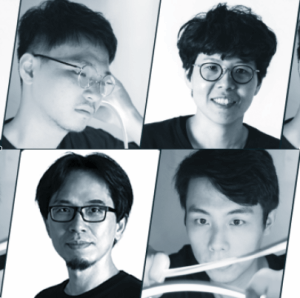In this article, we introduce Grandpa’s New Old Times: Reminiscent of the Past with Haptics and VR, a work by Mingcheng Wu, Yipin Huang, Wei-Chen Yen, and Chun-Cheng Hsu. As you read this article, you will learn more about the artists and how to view their work.
Artist Profiles
Mingcheng Wu, Yipin Huang, Wei-Chen Yen, and Chun-Cheng Hsu are members of a research team at the Institute of Applied Arts at the National Yang-Ming Chiao Tung University in Taiwan. They are researching VR and haptics interaction at the institute. In recent years, they have focused on designing haptics kits to understand the relevance of haptics immersion into virtual space through prototyping.
(Quoted from the official NEWVIEW website)
What is Haptics?
Haptics is a technology that provides cutaneous sensory feedback by applying force, vibration, or motion to the user…. Haptics can be used to create virtual objects with a subtly controlled sense of touch, enabling research into how the human sense of touch works. Such objects made it possible to systematically scrutinize human tactile functions, which had been difficult until then. Such research tools contribute to our understanding of how the sense of touch and the brain functions behind it work.
(Quoted from “Haptics” in Wikipedia, Japan)
Simply put, haptics is a technology that provides feedback to the user’s body. Thus, haptics gives the user the sensation of touching an actual object, such as a virtual reality (VR) controller vibrating in accordance with the action of a game, or a button being pressed like the home button on a phone. We explore the haptics technology used in Grandpa’s New Old Times. Let’s take a look at how the artists use haptics in this work.
Feeding Chickens Virtually
The research team uses haptics technology to create a deep, immersive VR experience of an older era.
Upon entering the VR space, visitors see a garden with large trees and many chickens. Nearby, food is provided for the chickens. Instead of a controller, the visitor holds a shovel developed by the team. Using the shovel, the visitor can distribute food to the chickens in the virtual space. The haptics technology in the shovel enables the shovel to vibrate in response to the scooping and scattering of food, creating a more immersive experience. Through this deep immersion, the research team strives to help elderly people with dementia remember the good old days.
Immersion in the New Old Times
Here is a comment from the research team on their VR work:
Grandpa’s New Old Times: Reminiscent of the Past with Haptics and VR is the result of a group work in the lab. It investigates how new technologies can take the elderly back to the good old days. As a part of gerontology, along with being entertaining, VR can be used actively in dementia treatment by designing meaningful nostalgic scenes. We designed a haptics kit that could be an add-on to the Oculus controller to increase immersion during the VR experience. We hope that in the future the elderly will be able to use the system we designed to get into the flow of the game and enjoy it. The sight was developed in Unity, using MAX/MSP to connect the position and state signals of Unity with the haptics kit and hardware vibration to simulate the illusion of tactile sensation. The shape, weight, and combination of the modules were carefully designed to give the user a tactile experience that matches what they are seeing.
(Translated quote from the official NEWVIEW website)
Gerontology is the study of aging and old age, which includes the health and psychological aspects of the elderly as well as how they connect with society and its challenges. Grandpa’s New Old Times was created as a part of this study. This VR work goes beyond the realm of entertainment and plays an important role in evoking memories. New technologies can bring about a new perspective of an original view of the past. Along with haptics technology, which gives an immersive sense of touch, visuals with striking, simple objects, such as chickens, gardens, and food, are key to evoking more memories.
Art and Medicine from the Perspective of VR
“Reminiscence” is a common therapy for dementia. In this type of therapy, people can look at, listen to, or touch nostalgic photos, music, or familiar objects from the past to evoke old experiences and memories and then talk about them with others. Recently, many companies have attempted to use VR to create more immersive therapies. For example, the British company Virtue Health is developing a digital therapy platform to support people with dementia based on this therapy.
Grandpa’s New Old Times is also structured along this therapy method of reminiscence. Recalling memories that lie dormant deep in the depths of the ocean of one’s experience can move one’s mind and bring a richness to those feelings. The research team’s VR work is like the movement of the mind that occurs when viewing art. Seeing someone’s work of art can trigger feelings of joy, sadness, wonder, and even more complex emotions, which are often completely different from the stimulation we get from everyday life.
Health is not only not being sick or frail in mind or body, but also being physically, mentally, and socially all comfortable and happy (well-being).
(Quoted from the website of the Japan WHO Association)
The field of art therapy is deeply rooted in applying research and techniques to medical treatment that will enable a movement of the mind related to the one that occurs when viewing art. For example, as a part of art therapy, a VR art project was conducted for palliative care at Hospice Savannah, an end-of-life care facility in the United States. This therapy, however, was an unrealistic virtual travel experience, as an effort for patients to forget for a moment their reality of pain and suffering from a disease. In the future, as art is applied to treatment in a variety of ways, the immersive nature of VR’s unique experience will bring innovative possibilities to therapeutic methods.
An Experience Beyond Entertainment
The challenge of “how new technologies can take the elderly back to the good old days” is an issue that is difficult to address solely in the realm of art. As can be seen from Grandpa’s New Old Times: Reminiscent of the Past with Haptics and VR in this article, Mingcheng Wu, Yipin Huang, Wei-Chen Yen, and Chun-Cheng Hsu had to develop their VR work while traversing various academic fields, such as art, medicine, gerontology, and haptics technology. Cross-disciplinary productions like Grandpa’s New Old Times have been increasing in recent years. As technology develops at a dizzying pace, new works can be created through exchanges with other disciplines, even if some knowledge alone is insufficient to keep pace with emerging technologies. In this context, initiatives such as this VR work will provide us with a wonderful experience that goes beyond entertainment and has the potential for medical and therapeutic breakthroughs.
How to experience a VR scene
If you are accessing this page from a smartphone, please click on the “Experience the Scene” button (*If you are experiencing the scene on a smartphone for the first time, please also refer to the following instructions).
After clicking, the following screen will be displayed.
If you have already downloaded the STYLY Mobile app, please select “Continue on Browser”.
You can then select “Play on Mobile App” to experience the scene.
If you have an HMD device, click the “Experience the Scene” button from your PC (web browser), then click the VR icon on the scene page.
Download the STYLY Mobile app
Download the Steam version of STYLY app
https://store.steampowered.com/app/693990/STYLYVR_PLATFORM_FOR_ULTRA_EXPERIENCE/
Download the Oculus Quest version of STYLY app
https://www.oculus.com/experiences/quest/3982198145147898/
For those who want to know more about how to experience the scene
For more information on how to experience VR scenes, please refer to the following article.






![[Summary] How to experience STYLY scenes VR/AR(Mobile) / Web Browser Introduction by step](https://styly.cc/wp-content/uploads/2020/04/スクリーンショット-2020-04-10-12.53.04-160x160.png)